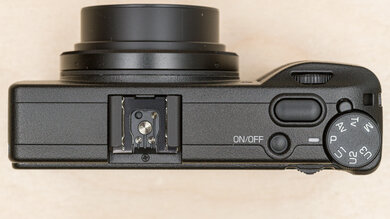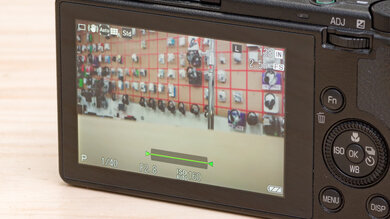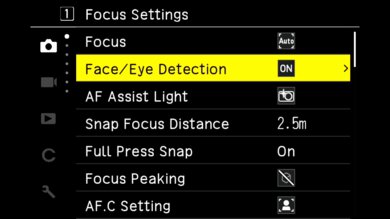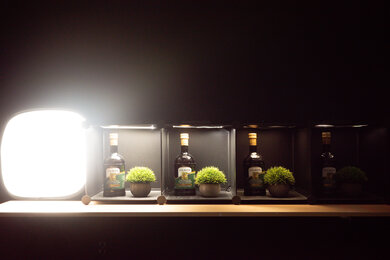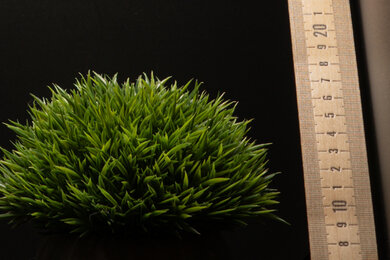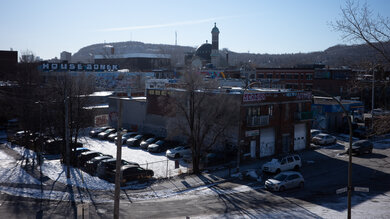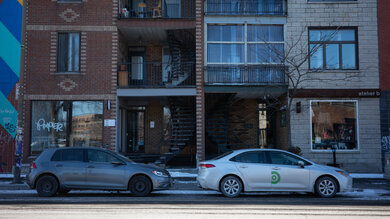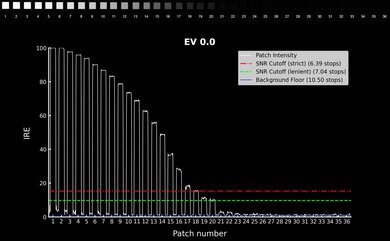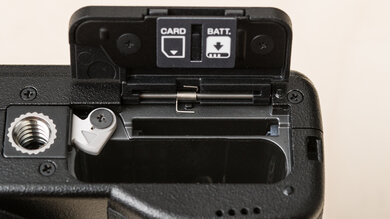The RICOH GR series is the go-to camera for enthusiasts who need a point-and-shoot camera that delivers high-quality images in a pocketable size, and the RICOH GR IIIx is no exception, making it ideal for street photography. The GR IIIx is identical to the RICOH GR III except for its lens, which has a 40mm full-frame equivalent focal length, as opposed to the wider 28mm equivalent on the original GR III. That more "natural" field of view is remarkably versatile for everything from street scenes to more isolated subjects. The camera's discreet minimalist design lets you blend in. Despite its unassuming form factor, the camera still has a relatively large and high-resolution APS-C sensor, along with extra features like built-in stabilization and a unique snap focus function that makes it easy to zone focus and take quick snapshots on the fly.
Our Verdict
The RICOH GR IIIx is good for travel photography. It's exceptionally portable and easily fits into a pocket or small bag. Image quality from its APS-C sensor is excellent, and though it doesn't have the most effective autofocus system, its unique snap focus feature can help you capture quick snapshots while out and about if you can accurately gauge your distance to a subject. Its built-in stabilization feature is also handy if you need to shoot at slower shutter speeds. Unfortunately, it doesn't have a viewfinder, and though its screen is sharp and bright, it doesn't tilt out, which can limit your flexibility with composition. Like most compact cameras, it also has a limited battery life, so you may need to pack a spare battery for long days on the go. Also, while it's well-built overall, there's no weather-sealing to keep out dust and moisture.
- Incredibly portable.
- Built-in stabilization.
- Excellent overall image quality.
- Poor autofocus tracking.
- Short battery life.
The RICOH GR IIIx is excellent for landscape photography if you need something compact. Its APS-C sensor captures excellent image quality, with a fairly wide dynamic range to bring out a broader range of detail in high-contrast scenes. Images also look sharp, and the camera performs well in low light, considering its sensor size, and is helped by a relatively wide-aperture lens. That said, the camera lacks a viewfinder or tilting screen, which makes composition a bit trickier. Its fixed 40mm equivalent focal length may not be wide enough for some landscapes. On the upside, it's incredibly portable and can even fit into your pocket, so it's a good choice for long hikes or to take to more remote shooting locations. However, you may need to pack an extra battery or two since its battery life is disappointing.
- Incredibly portable.
- Built-in stabilization.
- Excellent overall image quality.
- Fixed lens doesn't have a wide-angle field of view.
- Short battery life.
The RICOH GR IIIx is mediocre for sports and wildlife photography, but this isn't its main intended use. Its minimalist design, with no viewfinder and a fixed screen, can make composition a bit trickier. Beyond that, it doesn't have a very quick max burst rate, and its autofocus system does a poor job of tracking moving subjects. Its fixed 40mm equivalent lens also isn't well-suited to capturing far-away subjects. That said, its image quality is excellent, especially for a compact camera, and it isn't bad for more casual sports photography or photos of static subjects.
- Incredibly portable.
- Built-in stabilization.
- Excellent overall image quality.
- Poor autofocus tracking.
- Slow burst shooting.
- Fixed focal length lens.
The RICOH GR IIIx isn't intended for vlogging. Its video features are very limited, with no 4k recording and a fairly short recording time limit. Its video quality isn't great, and its screen is fixed, so you can't monitor yourself while recording.
- Incredibly portable.
- Limited internal recording capability.
- No 4k recording.
- Recording time limit.
- Short battery life.
The RICOH GR IIIx isn't intended for studio video. Its internal recording capability is very limited, and it doesn't record video in 4k. Its 1080p video quality is also quite lackluster. Beyond that, the camera doesn't have a headphone jack, mic input, or HDMI port to connect any videography peripherals.
- Incredibly portable.
- Limited internal recording capability.
- No 4k recording.
- Recording time limit.
- Short battery life.
The RICOH GR IIIx isn't intended for action video. Its recording options and frame rates are limited, with no high frame rate mode and no 4k video capability. Although it has a built-in stabilization feature that works well, the camera's overall video quality is disappointing.
- Incredibly portable.
- Built-in stabilization.
- Limited internal recording capability.
- No 4k recording.
- Recording time limit.
- Short battery life.
The RICOH GR IIIx captures amazing RAW image quality. It has excellent dynamic range, so it preserves a wide range of detail in the highlights and shadows. Its APS-C sensor also has a relatively high resolution, capturing plenty of fine detail for sharp-looking photos. Overall, it performs pretty well in low light for its class, with a fairly bright f/2.8 aperture lens and built-in stabilization to help you slow down your shutter speed. The camera also applies heavy noise reduction to its RAW files.
- Excellent dynamic range.
- Good low light performance.
- Images have plenty of fine detail.
Performance Usages
Changelog
-
Updated Mar 19, 2025:
We wrote text for the new tests added in Test Bench 0.13.
- Updated Feb 24, 2025: We've converted this review to Test Bench 0.13. We've added new tests for Video Dynamic Range and Luminosity Patch Detection. You can learn more about these updates in the changelog.
- Updated Jul 25, 2024: We've added a comparison to the Fujifilm X100VI in the Viewfinder section.
- Updated May 03, 2024: We updated the 'Differences Between Variants' section of the review to include information about the newly released RICOH GR IIIx HDF variant.
Check Price
Differences Between Sizes And Variants
The standard RICOH GR IIIx comes in one color variant: Black. There's also a limited 'Urban Edition' variant with a textured metallic finish and a navy blue lens ring cap. Beyond its exterior, the Urban Edition is functionally identical, aside from having a different graphic and logo when you power the camera off. In Japan, there was also a Special Limited Kit bundle of the Urban Edition, which included a matching leather hand strap and an optional metal hot shoe cover that could be engraved with a custom message. The Special Limited Kit has since sold out.
The GR IIIx is the sister model to the RICOH GR III. The only difference between them is the built-in lens. The original GR III has a 28mm full-frame equivalent focal length, while the GR IIIx has a 40mm equivalent.
RICOH announced the RICOH GR III HDF and RICOH GR IIIx HDF variants in 2024. The HDF variant includes a new 'Highlight Diffusion Filter' in the lens in place of the original model's ND filter. This filter softens and diffuses highlights to create a more dreamy, filmic quality to your images. In addition, the HDF model has a couple of new firmware features, including the ability to save up to 3 custom white balance pre-sets and a new 'Zone Select AF' area mode. These will eventually be added to the base models through firmware updates. The HDF model is physically differentiated from the base GR IIIx with a silver shutter button.
We purchased and tested the standard RICOH GR IIIx; you can see our unit's label here. Let us know if you come across any other variants, and we'll update the review.
Popular Camera Comparisons
The RICOH GR IIIx is a premium point-and-shoot camera aimed primarily at street photographers. Its no-frills design makes it incredibly discreet and portable. Unlike most compact cameras, it features a relatively large APS-C sensor and built-in stabilization. It also features a unique 'Snap Focus' feature that snaps the focus to a pre-set distance, which is useful for zone focusing and capturing fleeting moments. Otherwise, the camera's autofocus system isn't especially quick or reliable. While it can record 1080p video, the camera isn't really intended for extensive video recording. Although it keeps the camera more compact, the lack of a viewfinder or tilting screen can also be somewhat limiting for composition. Still, the GR IIIx is hard to beat among point-and-shoots for sheer portability and image quality.
For more options, check out our recommendations for street photography, travel, or the best compact cameras overall.
The RICOH GR III and the RICOH GR IIIx are identical cameras except for their built-in lenses. The GR III has a 28mm full-frame equivalent field of view, while the GR IIIx has a 40mm equivalent field of view. Which is better depends on which focal length you prefer to shoot at. The 28mm is wider and a bit better suited to landscapes or busier scenes that may require more coverage, while the 40mm is closer to the field of view of the human eye, making it versatile for a range of different subjects.
The Sony RX100 VII and the RICOH GR IIIx are both excellent premium point-and-shoots, though they're aimed at different uses. Both are extremely portable, but the Sony uses a 1-inch type sensor and a zoom lens, while the RICOH uses a larger APS-C sensor and a fixed focal-length lens. The RICOH is better for street photographers and enthusiasts who prioritize image quality and prefer to shoot at fixed focal lengths. In contrast, the Sony is more of an all-around point-and-shoot, as its zoom lens allows for more flexible framing, and it offers extra features like 4k recording and a tilting screen.
The RICOH GR IIIx and the Fujifilm X100V are both great point-and-shoot cameras with APS-C sensors. The Fujifilm is more feature-rich, with a hybrid optical/electronic viewfinder, a tilting screen, and 4k video capability. However, the RICOH is significantly more portable, with a minimalist design that makes it more discreet. The Fuji has a lens with a 35mm full-frame equivalent focal length, while the RICOH has a lens with a 40mm equivalent, so they offer similar fields of view, but you may prefer one over the other, depending on what you like to shoot.
Test Results

The RICOH GR IIIx is incredibly portable. Aside from its lens, which extends out a fraction further, it has the exact same dimensions as the RICOH GR III. You can see the camera with its lens fully extended here. The camera's small enough to fit into pockets or purses, making it exceptionally easy to take on the go.
The camera feels well-built overall. It has a magnesium alloy body that feels sturdy and lightweight. For the most part, the buttons and dials feel solid, though the rear command wheel feels flimsy. A locking hinged door covers the battery and SD card compartment, but the USB-C port is only covered by a rubber flap. Unfortunately, the camera isn't weather-sealed. Dust can get inside the lens and through to the sensor; while this is true of any camera, the GR IIIx's compact design and tendency to be stored in pockets makes it a bit more susceptible to lint and dust. Additionally, the ring cap is detachable and feels like it could be lost or broken somewhat easily.
The camera's minimalist design means there aren't too many buttons to work with, but even so, you still have three command "dials" to work with, so to speak. There's the front dial near the shutter, which is cleverly designed in a vertical orientation to keep the camera's profile down. Then there's the rear wheel, which you also use to navigate the menu, and finally, the multi-function compensation lever on the back, which can be pressed as a button or toggled back and forth to adjust exposure settings. All of these are customizable.
The camera has decent ergonomics, considering its compact size. It has a small hand grip, and though it can feel cramped for those with larger hands, the camera is designed to be comfortably used with one hand. The textured rubber around the side of the body provides sufficient grip, and there's a small protrusion on the back of the camera on which to rest your thumb. Despite its small size, the buttons are well-placed and easy to reach without accidentally making an unintended input. There are enough dials to control all of your exposure settings in manual mode, which is great. The camera also has a quick menu, accessed by pressing the ADJ button, that lets you adjust up to five settings, as you can see here. Most of the buttons and dials are customizable, too, including the video mode button on the side of the camera, and there are three custom user modes on the mode dial, so you can set custom settings for different shooting scenarios and easily switch between them. That said, there's no viewfinder, and the screen is fixed, making it harder to shoot at different angles. The lens also lacks a focus ring, so those who prefer to adjust focus manually have to use the notched rear dial, which doesn't allow for the smoothest focus adjustments.
This camera doesn't have a viewfinder. If having a viewfinder is important to you, consider an alternative like the Fujifilm X100VI.
The RICOH GR IIIx has a fixed screen with full touch capability. It gets bright enough to overcome glare and has a decently high resolution, though it isn't the most accurate for reviewing your images. There's also an 'Outdoor View Setting' that lets you adjust the brightness up to 2 steps beyond its normal setting for better visibility in sunny conditions.
The menu system is great. Though it's very extensive, with a lot of options and pages to navigate, the interface is simple, and the clear language makes it easy to find what you're looking for. You can navigate it using the touchscreen or the rear control wheel. The quick menu only has five settings, but you can customize them from 17 different options to quickly access your most frequently used settings. Unfortunately, there's no guide or help function to explain what the settings do for novice users. On that note, beginners in search of a full auto mode will have to look elsewhere. While there's no auto mode, you can still automate most of the shooting process by using Program mode. In any case, the camera is aimed more at enthusiasts and advanced photographers, and its interface reflects that.
The RICOH GR IIIx has a built-in lens with a fixed 40mm full-frame equivalent field of view; in contrast, the original RICOH GR III has a wider 28mm full-frame equivalent lens. There's also a crop mode that lets you set the equivalent field of view to 50mm or 71mm at the expense of some megapixels. The lens has a fairly wide max f/2.8 aperture. While that's slower than the lens on the Fujifilm X100V, it's still faster than most compact cameras, giving you a bit of leeway in low-light situations. The camera also has a built-in neutral density (ND) filter, rated at 2EV, that you can toggle on/off when shooting at the max aperture in bright conditions. Finally, there's a simulated anti-aliasing filter option that uses the camera's stabilization system to move the sensor around in small increments to reduce moiré and false colors. However, it works at the expense of resolution. You can set it to either 'High' or 'Low,' and it only works at shutter speeds slower than 1/1000s.
The RICOH GR IIIx uses a 24 MP APS-C sensor and GR ENGINE 6 processor. The camera also has what RICOH calls an 'Accelerator Unit' for its processor, which processes the sensor's signal output to reduce noise across the camera's ISO range and allows the camera to shoot up to an extended ISO of 102400.
Unfortunately, the camera has poor battery performance. It's CIPA-rated for only 200 shots on a full charge. However, CIPA ratings tend to be on the conservative side, and your real-world mileage will vary greatly depending on your settings and how you use your camera. Still, it's not a bad idea to pick up a spare battery for longer days on the go, especially since the camera can't be externally powered while shooting. Likewise, its video battery life is very poor. Even with its recording limitations and max 1080p resolution, it only lasts for a little over half an hour of continuous recording time.
The RICOH GR IIIx doesn't have the fastest shooting speed. Its max burst rate is quite slow, though you can still use burst mode to capture fleeting moments with the right timing. That said, the burst rate slows down even more when AF-C is enabled. The camera doesn't have an electronic shutter, so there's no silent shooting option. When shooting RAW files, the buffer fills up fairly quickly, though it's also pretty quick to empty once full. In JPEG, on the other hand, you can shoot indefinitely without it slowing down.
The RICOH GR IIIx uses a hybrid autofocus system and supports face/eye detection, but it does a poor job of tracking moving subjects. Combined with its slow burst shooting, that makes it a poor fit for action and sports photography. On top of that, shooting in burst mode causes the screen to blackout, so you can't see the subject you're tracking.
Having said that, the camera does have a unique 'Snap Focus' feature that lets you select a preset focus distance, to which it will quickly 'snap,' effectively bypassing any kind of autofocus delay. With 'Full Press Snap' enabled, the camera will snap to the preset distance when you press the shutter all the way, as opposed to half-pressing to engage the autofocus. You can also use 'Full Press Snap' by tapping the touchscreen. Snap focus is useful for those who prefer to zone focus and can take quick, discreet snapshots in situations where they can accurately gauge their distance to the subject. In other words, it can come in very handy for street photography. Additionally, there's a 'Macro Mode' that changes the focus distance to between 12 and 24 cm (4.7 to 9.4 inches) in front of the lens for close-up photography.
If you use a center focus point rather than relying on tracking, you'll likely get a better hit rate, but it's still disappointing overall. Screen blackout in burst mode makes it difficult to stay with your subject, and the camera is pretty slow to keep up.
The RICOH GR IIIx has built-in sensor stabilization, called 'Shake Reduction' by RICOH. It helps stabilize the sensor across three axes and is CIPA-rated for up to 4 stops of compensation. While it's naturally a more limited stabilization system than the ones found on larger cameras, the fact that it even has a sensor stabilization system and still maintains its compact form factor is impressive. The stabilization, in combination with the camera's size and short lens, makes it possible to get clear handheld images at remarkably slow shutter speeds.
The camera has excellent dynamic range, especially for an APS-C sensor. It can capture a wide array of highlight and shadow detail.
Note: At f/4, the camera's max shutter speed is 1/2500s. To measure the camera's dynamic range at a 1/4000s exposure time (with an ISO of 8000), we had to deviate from our usual methodology and use an aperture setting of f/5.6.
The RICOH GR IIIx uses a relatively high-resolution sensor, capturing images with plenty of fine detail. While cameras with higher-resolution sensors will give you even more leeway to crop your images, you can still punch in or use the camera's crop mode without losing too much visible sharpness and detail.
Our RAW noise measurements for the RICOH GR IIIx are significantly higher than expected. However, even after confirming that our methodology was correct and retesting the camera on different versions of Imatest, we kept getting similar results. While we can't confirm why the measurements are skewed, we suspect it has something to do with the 'Accelerator Unit' processing that the camera applies to RAW files to reduce noise. We also cross-referenced our results with the read noise results of the RICOH GR III, as measured by Photons to Photos, which you can consult here, and their data chart seems to confirm that the camera applies noise reduction in the ISO range beginning at ISO 200.
The camera can record videos in Full HD, but otherwise, its video features are quite bare-bones. Note that you can only use Program mode when recording video, meaning you won't be able to lock in your shutter speed relative to your frame rate, which can result in stuttered or blurry motion.
The RICOH GR IIIx can capture 1080p footage at up to 60 fps, so it's suitable for different video styles, including more cinematic footage or clear motion. However, it lacks a high frame rate mode for slow-motion recording.
The camera's internal recording capabilities are fairly limited, which isn't surprising considering this is a photography-first camera. You won't get very high-quality, high-bitrate video files, but it's fine for more casual use. The recording time is limited to 25 minutes or whenever your file reaches a 4GB file size.
The RICOH GR IIIx supports continuous autofocus in video, but there's no tracking capability. If you want it to focus on a specific subject, you'll have to use touch focus and manually adjust the focus while recording. Generally, the camera is very slow to adjust focus, so it's mostly suitable for situations where subjects aren't moving.
The camera doesn't exhibit too much rolling shutter distortion, so slanting vertical lines aren't too distracting, except when panning the camera quickly to the side.
The camera has poor dynamic range. Like the RICOH GR III, it doesn't support Log recording and has very limited video features. For instance, exposure control in video mode is limited to 'Program' mode. For that reason, we had to adjust our methodology to measure the dynamic range by changing the camera's exposure compensation setting and measuring at different EV values rather than different ISO settings.
Overall, the range of detail the camera can capture is limited. While the background noise floor is relatively high, you'll have very little latitude to make any exposure adjustments or recover detail in the shadows or highlights when shooting in challenging lighting scenarios.
Tested settings:
- Resolution: 1080p
- Frame Rate: 30 fps
- Log Format: N/A
Keeping with its minimalist design, the RICOH GR IIIx has a USB-C port for charging and file transfer and no other inputs. Unfortunately, that means you'll need an adapter to view your photos on an external display with HDMI, though it does support DisplayPort over USB-C. There's also no microphone input or headphone jack.



